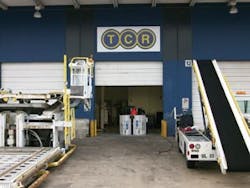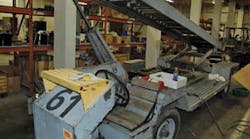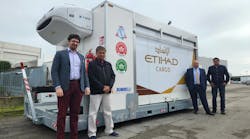By Aaron Amundson
While some companies in the ground handling business have established an intricate system of in-house support that allows their operations to run at near-peak maintenance efficiency, other companies may find it more difficult to cover the expense of constant maintenance and support of their GSE, and look to contract with outside service providers. Having established operations in Europe, TCR is looking to find a niche in the U.S. market with its model of GSE fleet support.
Business Model
TCR offers three main lines of service for GSE fleets: equipment rental, maintenance and fleet management. An “operational leasing” option encompasses all these services, centering around the complete management of ground support equipment — GSE availability, contract flexibility, technical and ramp assistance, preventive maintenance, as well as fleet management.
Under operational leasing, TCR would contract with a fleet operator, purchase the fleet, and absorb the shop maintenance program. Once this is done, they would rent equipment back to the operator on a monthly basis, with all maintenance provided as part of the lease.
TCR has found a customer base for operational leasing that primarily consists of ground handling companies operating at stations throughout Europe, according to Richard Janisse, vice president of finance & administration with TCR.
The benefit of this type of model is that TCR takes on all responsibilities regarding equipment maintenance, according to Janisse. “Ground handling companies have two core competencies. They service aircraft on behalf of their customers, but also they have to maintain their ground equipment,” he says. “To the degree that we have just the one core competency of maintaining ground equipment, we can provide a good service to them, and let them focus on their core competency, which is maintaining and servicing the aircraft.” he says.
Another benefit under the operational lease, according to Janisse, is the flexibility to add or remove units from the fleet when needed. “If a ground handling company lost a contract with an airline, we could adjust their operational lease and take that ground equipment they were using and distribute that to other locations that needed it, or we could sell it,” he says. “On the other side, if they get a new contract and they need more equipment, we can certainly provide that and roll that into the fleet conversion contract and rent that to them.”
The operational lease also allows for fleet changes and modernization within the rental structure. Janisse says that the company is willing to design a fleet based on the budget and requirements of customers. “If they want new equipment, we can outfit them with new equipment.” he says, “If the customer would rather purchase a used piece of equipment, we’ll find a very good piece of used equipment for them.” As an operation, TCR not only leases and maintains, but also refurbishes and sells equipment.
Expansion
In Europe TCR operates at 50 airports in seven different countries. They have now focused on North America as a region of growth. “The U.S. market is pretty big, actually much bigger than the European market, and like other European-based companies that are expansion-minded, the U.S. is a fertile area to expand into,” he says.
The transition has been largely organic, as TCR moves its services to fill the needs of foreign-owned handling companies. “The expansion to the U.S. is basically looking to the European clients that have operations over in the U.S., and expanding with them in the same fashion that they have over in Europe,” he says.
In addition, the company sees a niche in the U.S. market for the services they provide. As he puts it, “There are companies that lease ground equipment to ground handlers, and companies that maintain it, but there is nobody out there in a big way that is providing both, and that’s what TCR does.”
U.S. Operations
Currently TCR’s U.S. operations are based in Houston as part of their collaboration with Menzies Aviation. The partnership began in late 2009. Describing the current arrangement, Janisse says, “Menzies is actually located in a warehouse that is immediately off the airport. What we did is sublet their shop area and some office space from them.” He goes on explain that, following the European model, they have assumed control of all maintenance services, parts storage and inventory.
At present, the Houston operation is TCR’s sole U.S. operation. “We’ve got five mechanics now, an office manager, and a couple of management personnel, including our VP of operations, who spend most of their time down there,” he says. This operation supports a fleet of 74 motorized GSE and 338 non-motorized GSE — 412 pieces in total.
According to Janisse, the company is looking at other locations of growth. “We’re looking to expand at Houston airport, and were looking at other airports across the United States,” he says.
The ideal market for a service like this is variable. “Our target market is an airport operation that has 200-plus pieces of equipment,” he says. “If you get into smaller operations, you’ve got to spread the monthly rental fee that includes the overhead for the shop and the people over fewer pieces of equipment.”
In its European operation, TCR has contracted with airlines directly to provide operational leasing, and the opportunity is being pursued in the U.S. as well. Janisse says the company sees opportunity in “outlying cities that the airlines fly to where they’ve got a couple hundred pieces of ground equipment and a shop.”
As for short-term goals, TCR is exploring other opportunities to grow their business in the U.S. According to Janisse, several areas that show promise are fleet conversions for
compliance, expansion with current European customers, and contracted maintenance and repair with companies where the leasing model doesn’t work. In addition, TCR plans to establish a U.S headquarters within the year, which will facilitate — as it hopes — the larger staff needed as contracts are finalized and the U.S. operation grows.





